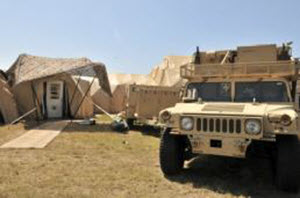The road to a Texas Guard Warfighter, part 1 of 3
Story by: Sgt. Elizabeth Pena
Posted: September 17, 2015
 Sgt. Elizabeth Peña
Sgt. Elizabeth Peña
Texas National Guardsmen of the 136th Maneuver Enhancement Brigade, headquartered in Round Rock, Texas, conduct a command post exercise at the Round Rock Armed Forces Reserve Center, Sept. 11-13, 2015, as a ramp up to their Warfighter Exercise scheduled for Nov. 2015 at Fort Campbell, Ky. (Photo by Army National Guard Sgt. Elizabeth Pena/Released)
ROUND ROCK, Texas - The Soldiers of the Texas Army National Guard’s 136th Maneuver Enhancement Brigade serve their state and country with two necessary and complementing missions. Stateside, they help their fellow Texans during emergencies with search and extraction, decontamination, and medical triage capabilities. Overseas, they fulfill the Army’s mission to fight and win our nation’s wars through security and maneuver support operations.
This wartime mission requires extensive preparation and practice to achieve proficiency. Their barometer of success is the Warfighter Exercise, a three-week command and control simulation that tests and evaluates a headquarters’ coordination and methods of battle. Although their validation is not until November, the brigade’s journey to success begins months in advance, with command post exercises at its home station.
“This allows us to have trained soldiers, competent in their tasks and skills with coordinating efforts by other sections throughout the organization,” said Chief Warrant Officer 2 David Esparza, the Brigade Information Services Technician. “It takes intensity. To be part of the MEB, you have to challenge yourself and Warfighter is a challenge we are definitely taking on.”
The command post exercises, held in July and September 2015, serve as preparatory rehearsals and proofs of concept for what they’ll encounter when they travel to Fort Campbell, Kentucky, in November. The two exercises give the 136th MEB an opportunity to achieve unity of efforts across staff teams by allowing Soldiers, officers and enlisted alike, to define their individual roles and responsibilities and gain a better understanding of Warfighter as a whole.
“The feedback that we are getting on some of our products is great,” said Cpt. Carl Wilson, the brigade’s deputy logistics officer. “The collaboration with the advisors and trainers from the 101st will have long-lasting effects not just here and now, but further down the road in Kentucky.”
During the second command post exercise, held September 11-13, the Guardsmen teamed up with their active-duty counterparts from Fort Hood’s 1st Cavalry Division in field services, current operations, fires supports, knowledge management, and logistics to better understand the procedures and practices that will ensure a successful Warfighter.
“Everyone here wants to be part of a team,” said Esparza. “Anything you want to learn, you will be given opportunities to cross-train. We welcome anyone to come in and see how they can fit in and start working with direction and motivation.”
This is the first Warfighter for the 136th MEB since their deployment in 2012. Although this is not a mobilization, it still requires vast amounts of support, including supplies, maintenance gear, and transportation of equipment and Soldiers. The logistics section serves as the primary advisor for these tasks.
“Approximately 200 Soldiers from the brigade will be participating in Warfighter,” said Wilson, “requiring about 350 cases of MREs and a water buffalo that holds 400 gallons of water. Generators, HMMWVs, and LMTVs will be transported to Fort Campbell in late October prior to the main body movement.”
Crucial to mission success, communication support was another key element in learning how best to respond to the demands of a fast-paced, tactical environment. The brigade’s computers, telephones, and other electronic equipment requires 7,000 ft. of ethernet cable for the more than 500 different connections.
“We have to monitor networks, communication channels, information systems, and tactical systems,” said Esparza. “It is the architecture we build from the ground up at any location.”
The brigade is no stranger to self-sustaining operations through extensive practice with their Deployable Rapid Assembly Shelter system in isolated areas without infrastructure. This command post exercise demonstrated once more the 136th MEB’s ability to establish a tactical footprint and execute their support mission.
“The way we prepared for this weekend was getting the personnel ready,” said Esparza, “as well as the communication pieces, the logistical support, cables, wires, and any other supplies we might need in order to make this happen.”
The Guardsmen will complete their final preparations in October before moving out November 4th for Fort Campbell. There, they will use the skills, products, and battle methods developed at their command post exercises during these summer months to achieve success at their culminating evaluation.
“Without this CPX, we could not perform well in Kentucky,” said Wilson. “I know for a fact they are setting us up for success.”